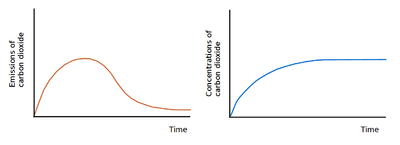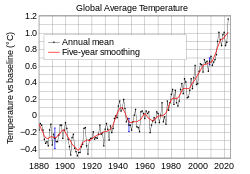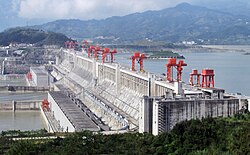Projected global primary electricity consumption by source, over the 21st century, for a climate change mitigation scenario
The graph shows how a variety of energy sources contribute to PEC. It also shows how energy consumption is reduced compared to a "reference scenario", in which no efforts are made to reduce greenhouse gas emissions.
In the scenario, PEC increases over time, from 387 exajoules (EJ) in 2000, to 666 EJ in 2100. Energy savings contribute significantly to reductions in energy use compared to the reference scenario. In the reference scenario, PEC increases from 387 EJ in 2000 to 1344 EJ in 2100.
The graph shows that fossil fuels dominate PEC in 2000. By 2060, most coal is used with carbon capture and storage (CCS), with a increase in the share of PEC supplied by commercial biomass. In 2100, the percentage contributions to PEC are: energy reductions 51; coal with CCS 13; coal without CCS 0.4; commercial biomass 17; natural gas with CCS 3.8; natural gas without CCS 1.9; non-biomass renewables 3.3; nuclear power 1.5; oil 8.4.
Data
Data for the mitigation scenario are summarized below. The full set of data are provided in a later section as comma-separated values (CSV). The data below summarizes PEC by source in EJ. Energy reductions in the mitigation scenario are equal to total PEC in the reference scenario minus total PEC in the mitigation scenario. Data are provided for the years 2000, 2050, and 2100, respectively:
- Energy reduction: 0.0, 394.5, 677.6
- Coal w/CCS: 0.0, 106.8, 173.6
- Coal w/o CCS: 98.9, 12.3, 5.8
- Commercial Biomass: 0.0, 147.5, 232.6
- Natural Gas w/CCS: 0.0, 33.0, 51.5
- Natural Gas w/o CCS: 81.8, 71.1, 24.9
- Non-Biomass Renewables: 22.5, 26.6, 44.0
- Nuclear: 25.6, 16.1, 20.5
- Oil: 158.1, 121.9, 113.1
- Total (reference scenario): 386.9, 929.8, 1343.7
- Total (mitigation scenario): 386.9, 535.3, 666.1
The following data shows the percentage contribution of sources to total PEC. Data are provided for the years 2000, 2050, and 2100, respectively:
- Energy reduction: 0.0, 42.4, 50.4
- Coal w/CCS: 0.0, 11.5, 12.9
- Coal w/o CCS: 25.6, 1.3, 0.4
- Commercial Biomass: 0.0, 15.9, 17.3
- Natural Gas w/CCS: 0.0, 3.6, 3.8
- Natural Gas w/o CCS: 21.1, 7.6, 1.9
- Non-Biomass Renewables: 5.8, 2.9, 3.3
- Nuclear: 6.6, 1.7, 1.5
- Oil: 40.9, 13.1, 8.4
Data sources
Scenario data are taken from Clarke et al. (2007)[1] The graph is based on the "IGSM_REF" reference and "IGSM_Level1" mitigation scenarios. Data from Clarke et al. (2007)[1] are in the public-domain, and are included in a following section. The report by Clarke et al. (2007)[2] includes a graph similar to this one.
Notes
- ↑ a b CCSP-2-1A-Scenario-Information-070707.xls, in Clarke & others 2007
- ↑ Figure 4.10, in: Chapter 4: Stabilization Scenarios, in Clarke & others 2007, p. 103
References
- Clarke, L., et al. (2007-07) Scenarios of Greenhouse Gas Emissions and Atmospheric Concentrations. Sub-report 2.1A of Synthesis and Assessment Product 2.1 by the U.S. Climate Change Science Program and the Subcommittee on Global Change Research[1], Washington, DC., USA: Department of Energy, Office of Biological & Environmental Research
Relevantní obrázky
Relevantní články
Zmírňování změny klimatuZmírňování změny klimatu, často také mitigace změny klimatu, jsou opatření, která mají omezit velikost a rychlost dlouhodobých klimatických změn. Z politického hlediska se jedná o konkrétní obsah politiky ochrany klimatu. Zmírňování změny klimatu obecně zahrnuje snížení lidských (antropogenních) emisí skleníkových plynů (SP). Zmírnění může být také dosaženo zvýšením kapacity ukládání uhlíku, například prostřednictvím znovuzalesňování. Mitigace tedy řeší příčiny, naopak adaptace na globální oteplování jsou zaměřeny na jeho důsledky a označují opatření přijatá pro obranu proti jeho možným nebo nevyhnutelným dopadům, např. budováním hrází v reakci na zvyšování mořské hladiny. .. pokračovat ve čtení



















